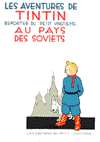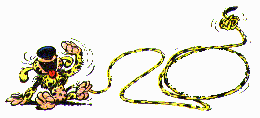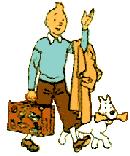![[IMAGE]](tintbmed.jpg) The most famous Belgian comic: Tintin!!!
The most famous Belgian comic: Tintin!!!
![[IMAGE]](tintbmed.jpg) The most famous Belgian comic: Tintin!!!
The most famous Belgian comic: Tintin!!!
European Comics bloomed after WW II, especially in Belgium, France, Italy and England. As most of you certainly know Tintin, few only could point Belgium as Tintin's native land. However, the Belgian contribution to the Comics' universe was certainly not limited to the world famous reporter and to his small dog Snowy (Milou, in French- the original language of the Tintin stories). The forties and the fifties saw the apparition of an incredibly rich and diversified production of comic books in Belgium.
THE REVIVAL IN THE SEVENTIES The end of the sixties and early seventies saw a tremendous revival in the Comics in Belgium and France:
as well by the creators as by the interest of the readers, young..and not so young...!
The end of the sixties and early seventies saw a tremendous revival in the Comics in Belgium and France:
as well by the creators as by the interest of the readers, young..and not so young...!
Brussels, Charleroi and Liège were the Belgian towns were the majority of the creators and publishers were concentrated.
As Belgium has not a large population (10 Million), with two main national languages: French and Dutch (Flemish)
it was necessary to keep France and The Netherlands as a natural market for the Belgian comics.
By the reputation of quality and appeal to a mixed public (kids, young teen-agers ...and adults)the success rapidly
grew farther out of the borders of Belgium.
A MIRACLE: TWO BELGIAN COMICS MAGAZINES
The local growth of talents was fueled by two incredibly high quality magazines for the youth: "Spirou"(1938) and...
"Tintin" (this one appeared only in 1946). The publishers of these magazine could detect and develop talents such as: André Franquin, Edgard Jacobs, Morris,
Maurice Tilleux, Jijé, Willy Vandersteen, Jacques Martin, Peyo, Roba, Walthéry... and so many others until the mid eighties. Looking back to collections of these magazines
seems like entering the world of a wizard: all the Belgian talents in comics were present! All the fabulous characters started their lives in these mags.
Event![]()
 1996 should have seen the 50th year of the Tintin magazine: the first issue was published in French in Belgium the 26th September 1946.
1996 should have seen the 50th year of the Tintin magazine: the first issue was published in French in Belgium the 26th September 1946.
Le journal Tintin (Tintin's journal) was an immediate success! It carried the famous slogan in its front page: For the Young from 7 to 77 years (Pour les Jeunes de 7 á 77 ans).
<<<Cover of the first issue
A French Website devotes a few pages to an interesting description of the early days of the Tintin magazine: Les débuts du journal Tintin
Well documented and accurate it is a good reminder of the Belgian golden age for comics. A must for Tintin lovers and anybody interested in Belgo-French comics!

European comics on the WEB: the best for graphic sources
and for the most complete lists of links for the Comics in Europe.
Erik Tjong Kim Sang, creator of the site is a University researcher in fundamentals for computer applications.
He is presently working in Sweden.
Erik is a great fan of European comics and a real amateur, as proved by his own articles !
Big parts of the lists are dedicated to the Belgian comics because of their success and qualities.
European Hard-Boiled Comics: A selection of some of the best European comics production having detective/crime stories as topics, with tough guys and gals handling the situations. Can be borderline to Noir, similar to this genre of rough tales developped in films and mystery novels. Meet Canardo, Nestor Burma (Tardi), Largo Winch and more.
Brussels's Museum for Comics and Cartoons (Musée de la BD)
CBBD- Centre Belge de la Bande Dessinée, is its official name.
This museum, unique in the world, is installed in the very heart of Brussels in a historical architectural building
designed by Horta for industrial use.
It was converted to an exhibition center for the "comic strips"
(bande dessinée as they are called in French, BD in short and colloquial).
Their incredible collections of albums, magazines and books, as well as original works from authors (drawings and writings)
are all dedicated to the Comics.
One of the most original cultural realization in Belgium for decades!
Visit the official WEB site of this dream museum by following this link.
 Check out Le calendrier du Centenaire- The Calendar of the Centennial-text in French only, but an exceptional source of
info about Belgo-French Comics; a superb compilation that gives topics (related to the Calendar dates) about the Belgian comics creators and their works.
Comics from other origins are presented as well. A GREAT work by this French team. Created for the WEB in 1996 : the history of modern comics was 100 years old!!
Check out Le calendrier du Centenaire- The Calendar of the Centennial-text in French only, but an exceptional source of
info about Belgo-French Comics; a superb compilation that gives topics (related to the Calendar dates) about the Belgian comics creators and their works.
Comics from other origins are presented as well. A GREAT work by this French team. Created for the WEB in 1996 : the history of modern comics was 100 years old!!
 Tintin, the Grand-Daddy of the Belgian comics!
Tintin, the Grand-Daddy of the Belgian comics! Hergé was a great artist with a typical clear construction of his drawings. He refined this style of drawings during all his life and became the
uncontested master of the style called : the clear line (la ligne claire). Most of the images of any of his comic strips can be viewed as a self contained
illustration, graphically equivalent to a poster. But Hergé could obtain this result without affecting the continuity of the story (continuity
= construction of the follow-up of the
images to tell visually the story or script that keeps relations between all of them, in a strip, page or complete album).
Hergé was a great artist with a typical clear construction of his drawings. He refined this style of drawings during all his life and became the
uncontested master of the style called : the clear line (la ligne claire). Most of the images of any of his comic strips can be viewed as a self contained
illustration, graphically equivalent to a poster. But Hergé could obtain this result without affecting the continuity of the story (continuity
= construction of the follow-up of the
images to tell visually the story or script that keeps relations between all of them, in a strip, page or complete album).
Copyright © 1996, 1997,1998,1999,2000,2001 E.Borgers for text and setup.
Proprietary graphics, photos, illustrations remain the full property of the rights holders.
(see complete disclaimer in front page)
This Page was created with WebEdit 12 July, 1996
Most recent revision, 21 October, 2005